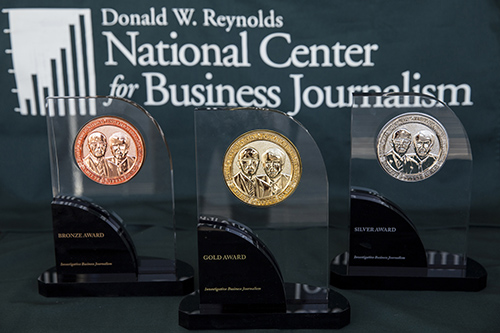Last week the 2016 Barlett & Steele Silver Award was given to “Testing Theranos,” the Wall Street Journal’s devastating investigation into startup Theranos. WSJ reporters discovered that the company’s ballyhooed blood test was seriously flawed, and that Theranos had lied to investors, partners and the medical community. In their own words, here’s how they did it.
The Wall Street Journal’s reporting and editing of Theranos was an unusually long and painstaking process, taking 10 months before the first article was published amid denials, attempted intimidation of sources and multiple litigation threats.
The blood-testing company first came on the radar of the Journal’s John Carreyrou when he read a profile of its founder Elizabeth Holmes in The New Yorker magazine in late 2014. The article described a brilliant scientist and entrepreneur who’d achieved great things at a young age. Some passages gave him pause, including this one: “What exactly happens in the machines is treated as a state secret, and Holmes’s description of the process was comically vague: ‘A chemistry is performed so that a chemical reaction occurs and generates a signal from the chemical interaction with the sample, which is translated into a result…’ ”
A few weeks later, Carreyrou got a tip that everything might not be what it seemed at the company. He was intrigued, given that Theranos had achieved a $9 billion valuation and become one of Silicon Valley’s hottest startups. He spent several weeks digging further until he reached a former employee who, after much give-and-take, agreed to become a confidential source. Theranos lawyers were harassing the former employee and threatening him with litigation. It took several more months to corroborate what this source was saying with other former employees, some of whom let Mr. Carreyrou review documents that backed up their claims.
When the Journal confronted the company with its findings based on the reporting thus far and sought its input, Theranos waged an aggressive campaign to discredit Mr. Carreyrou and his sources. Sunny Balwani, Theranos’s president, flew to the Phoenix area, where Theranos was offering its blood tests in Walgreens stores. There, some doctors who had talked with Carreyrou said Mr. Balwani pressured them to recant their statements. The famed litigator David Boies came twice to the Journal’s newsroom in midtown Manhattan to discuss the issues and tried to get the story killed.
The Journal’s top editors and lawyers, who had closely monitored Mr. Carreyrou’s reporting from an early stage, unflinchingly stood by him. In editing the initial piece, we took a straightforward approach, measuring Theranos’s claims against the reality former employees could substantiate, beginning with an iconic photo of Ms. Holmes on Theranos’s website holding up a tiny vial to show how the company made it possible to quickly process the full range of laboratory tests “from a few drops of blood.”
The first article was published on Oct. 15, 2015, 10 months after Carreyrou first started working on it, and it hit Silicon Valley like a tornado. Angel investor Jason Calacanis, one of the earliest investors in Uber, called it “a watershed moment” in the rush of cash that had propelled some 200 private tech companies to “unicorn” status, with valuations of $1 billion or more. Bill Gurley, a prominent venture capitalist, called it “perhaps the seminal bubble-popping event.” Business and technology writer Kevin Roose named it one of the best business and tech stories of 2015, writing that it was “devastatingly well-researched and thorough.”
The Journal’s Christopher Weaver and Michael Siconolfi primarily handled the reporting involving Walgreens, the drugstore giant that had planned to open thousands of Theranos “wellness centers” in its pharmacies around the nation. The partnership was Theranos’s main pathway to consumers. The Journal tracked how Walgreens had plunged into the Theranos tie-up without doing traditional due diligence, and how it slowly pulled back from its agreement with the laboratory firm amid the revelations of problems with Theranos’s testing technology.
The impact of the Journal’s reporting has been profound. Theranos has voided two years of blood-test results generated by its proprietary machine and sent doctors tens of thousands of corrected test reports. Mr. Balwani, the president, has resigned. Walgreens has ended its partnership with the company. Federal health regulators have decided to shut down Theranos’s California laboratory and to ban Holmes from the blood-testing business for at least two years, citing unsafe practices that put patients in “immediate jeopardy.” She is appealing the sanctions, and they haven’t been implemented, pending that appeal. Theranos says it is cooperating with government authorities as it faces criminal and civil investigations by the U.S. attorney in San Francisco and the Securities and Exchange Commission.
In October, Theranos shut down its blood-testing facilities, in a dramatic retreat from Ms. Holmes’s core strategy of offering a long menu of blood tests directly to consumers, leaving its patients in the lurch. Meantime, the Journal is continuing to report additional threads to the saga.










